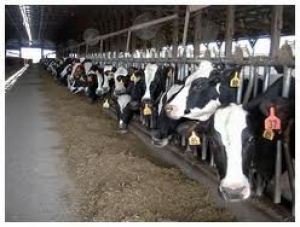Fertility and Reproduction
Understanding and Improving Dairy Fertility: Fertility & Reproduction

Oestrous behaviour, follicle development, and embryo-maternal interaction are important links in processes underlying successful reproduction in farm animals. In this project the understanding of the genetic regulation and physiology of these important aspects of fertility has increased. This may contribute to a multi -trait approach in which production traits as well as traits regarding fertility, health, and robustness are addressed.
Why fertility?
Efficient reproduction is important for viable livestock production enterprises. To produce agricultural products (like milk, meat and eggs), good animal fertility is essential. It affects production efficiency and hence product retail prices significantly. To the farmer, good animal fertility is essential for herd management and for profitable farming. The economically optimal calving interval for dairy cows is one year. Getting dairy cows pregnant is however a major problem, as fertility rates have declined strongly over the last decades. Moreover, expression of oestrous behaviour has declined, which makes it difficult for farmers to know when the cow needs to be serviced. Half of the dairy herd replacements occur involuntary and poor fertility is one of most important causes. High replacement rates have major implications for animal welfare and sustainability of animal production. Besides, it limits the possibilities for selection and reduces economic efficiency. Direct genetic selection for fertility is hampered by its relatively low heritability and the lack of easy-to-measure parameters for fertility.

Research to understand fertility
The project aimed to understand several processes underlying good reproductive performance and to identify crucial genetic factors in these processes and markers for fertility-related genes. This knowledge improves the possibilities for breeders to increase the genetic merit of farm animals for fertility and the genetic merit for productivity in general.
Behaviour
During oestrus, mechanisms in specific brain areas start or facilitate female sexual behaviour. In these brain areas we have identified various genes and clusters of genes that are switched on (or off) during oestrous. In addition, many genes were found to be associated with the intensity of the sexual behaviour (heat score) of the cows. Various methods are employed to find the biological function of the genes and the metabolic pathway they participate in. Thus, candidate genes for the regulation of oestrous behaviour are being identified.
Embryo development
The chance of successful development of an embryo depends on genetic factors of both the embryo and the mother’s endometrium.
A number of genes were identified that become active aft er arrival and towards implantation of the embryo in the uterus. Expression levels of genes identified in both endometrium and embryo can predict successful development of the embryo into a calf or lamb.
Genetic markers
Progress was made in finding the location of a small defined genetic region (QTL) of bovine chromosome 7 that affects fertility. SNP markers for both fertility and twinning were identified on that chromosome. Within the defined region of the QTL, a highly significant SNP was found but this was not in the causative gene.
Ontology
Ontology involves precise definition of animal trait terminologies (phenotypes) to help with correctly linking phenotypic data to structural and functional genome information in various databases. We developed a reproduction ontology that will help perform searches in databases and allows meaningful comparisons of reproduction terminologies within and between species.
Sustainable breeding
The achieved understanding of function and location of genes regulating fertility may contribute to a multitrait approach in which both production traits and traits regarding fertility, health, and robustness are addressed, thus contributing to sustainable breeding.
January 2012





















